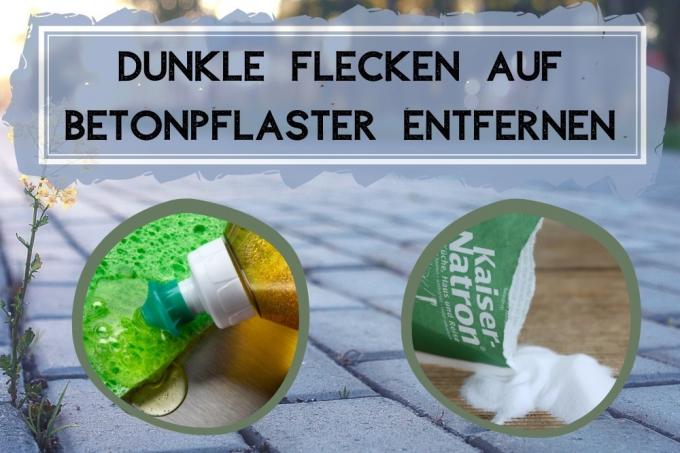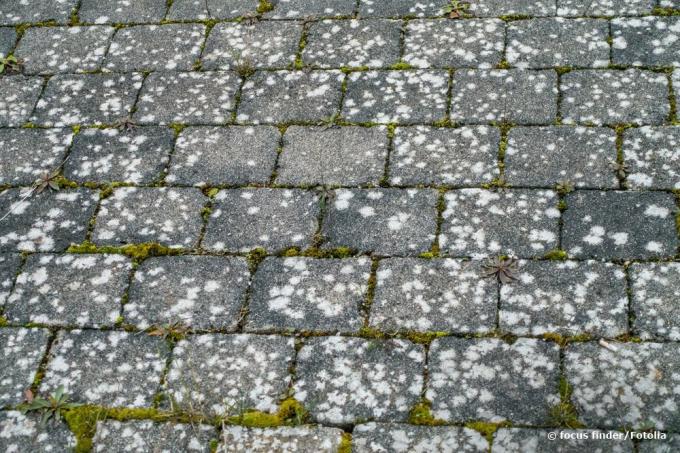
table of contents
- Preparations
- Detergent against tire marks
- Anti-lichen bleach
- Soda against mold
- Soda paste against algae growth
- Stain remover against bird droppings
- Prevent discoloration
When dark spots appear on the concrete pavement, you need to act quickly. Algae, lichens and fungi, but also bird droppings or tire tracks can be the cause.
Preparations
Dark residue on the patch can have a number of causes and several home remedies can be used to get rid of it. Before treating stains, you should remove coarse soiling. Sharp-edged sand is an ideal cleaning agent for large-area paving stones. Spread the substrate over the surface with a broom. The fine grains polish the surface and loosen dirt, which is then swept onto a dustpan along with the sand. Therefore, use suitable methods to remove stains. If the measure does not work, you should try other means and combine different applications with each other. Patience is often required, as deeply burned-in discoloration only slowly fades.

Detergent against tire marks
Residues from car tires are easy to clean because they exist on the surface and do not penetrate very deeply into the pore structure of the paving stones. Fine traces can be removed easily with an eraser or sponge. Use an environmentally friendly and solvent-free cleaner for stubborn stains:
- Put biodegradable detergent in water
- Adjust the amount of detergent to the degree of soiling
- Pour the solution on the affected areas
- Work in the agent with a soft brush or sponge
- leave on for about 20 minutes
- Rinse the surface with clean water
Anti-lichen bleach
This group of organisms colonizes extreme habitats such as cobblestones that are both in the shade and in the sun. There are lichens that are relatively easy to scrape off with a spatula. Other types require more effort through intensive cleaning with a wire brush. In addition, there are lichens that penetrate deep into the pores and cannot be removed mechanically. A Bunsen burner helps to kill such stains. In order to make the residue left on the concrete pavement disappear, the following procedure is recommended:
- Put hydrogen peroxide on the stains
- Let the agent work so that it breaks down into water and oxygen
- Remove dead lichens thoroughly with a wire brush

Note: High-pressure cleaners are not useful in the case of lichen and fungus infestation. Due to the pore-deep cleaning, moisture penetrates the paving stones, so that organisms colonize again after a short time.
Soda against mold
Fungal spores find optimal growth conditions and nutrients on almost any surface. They therefore prefer to settle on shaded cobblestones. The smallest deposits of algae or lichens, which rot through natural processes, provide the spores with a good breeding ground. If the mold has settled in the concrete pavement, it leaves unsightly stains. These are often reminiscent of mold stains in damp laundry and are difficult to remove. By changing the pH value, however, you kill the fungal mycelium. In order to reduce unsightly stains in the plaster, you should therefore take the following measures regularly for at least three months:
- Dissolve five tablespoons of soda in five liters of water
- Pour on the affected areas and leave to act
- Treat the plaster thoroughly with a brush
- Spray the concrete pavement with a garden hose
Attention: True, vinegar is an ideal means of killing mold. However, outdoor use on sealed surfaces is not permitted.
Soda paste against algae growth
Black algae are often responsible for dark discoloration on stones and are therefore often mistaken for road dirt. The organisms prefer to settle on the edges of shaded stones, as there is a humid microclimate here. If they are not removed in time, the algae growth can spread over a large area. This measure has proven itself for stubborn stains:

- Mix four tablespoons of cornstarch with 100 grams of baking soda
- Add lukewarm water until a paste is formed
- Apply the agent to the discoloration and leave it on for five hours
- Thoroughly scrub concrete pavement and rinse off residue with water
Stain remover against bird droppings
The remains of birds often contain dye pigments from berry fruits, which cause blackish discolouration on the plaster. The dyes penetrate deep into the pores as a result of moisture, so that the stains become more difficult to remove as they get older. As soon as you spot bird droppings, remove them with warm water and a few drops of washing-up liquid. With this stone care product you can remove stubborn discoloration:
- Boil five liters of water
- Dissolve 50 milliliters of soft soap and 30 grams of washing soda as a cleaning agent
- Add 30 milliliters of glycerine as an impregnating agent
- Mix in 60 grams of commercially available stain remover as a dye destroyer
Prevent discoloration

That Removing stains on concrete pavement can be a test of patience. Mechanical measures often affect the concrete pavement, so that the roughened surface offers an improved surface for discoloration. Regular cleaning is recommended so that there are no unsightly residues. Get rid of accumulated autumn leaves and fallen fruit from nearby trees. Make sure that no puddles form on the stones. A dry subsoil is not an ideal breeding ground for fungi and lichens. A seal protects the plaster from penetrating root plexuses and color pigments. In addition, smooth surfaces prevent the growth of various organisms.

